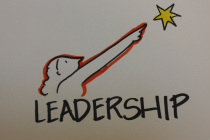 In a previous post, I presented the need to move from systems thinking to systems being. There is a reason for that: I believe that it is through systems being that we will be able to truly transform our world. And transforming the world is the task of leaders. However, the most prevalent understanding of leadership is narrow and hierarchical: one leader on top and many followers below; few with power and many powerless. As members of society and organizations, we have accepted a passive, victim stance in the face of complex challenges while we point fingers hoping that elected officials and business executives take care of our problems. Our behavior represents a relinquishing of our power. We suffer the problems but we don’t see ourselves as part of the solutions. And if we find ourselves dissatisfied about our leaders, we act as if we can’t do anything about it. This distorted concept of leadership needs to be revised and expanded, because it is not very useful and it may be dangerous in today’s world. By our mere participation in social structures through our daily lives, we are creating our future. But we haven’t done so consciously. Peter Senge shares the view that "ultimately, leadership is about creating new realities." He once said, "Because of our obsession with how leaders behave and with the interactions of leaders and followers, we forget that in its essence, leadership is about learning how to shape the future.... Leadership exists when people are no longer victims of circumstances but participate in creating new circumstances. Leadership is about creating a domain in which human beings continually deepen their understanding of reality and become more capable of participating in the unfolding of the world.” In our blindness to our own power as participants and co-creators—as leaders—in “community,” we too often give up our right and responsibility to co-author the narrative of our lives. Author Parker J. Palmer expressed this notion beautifully. "'Leadership,'" Palmer once wrote, "is a concept we often resist. It seems immodest, even self-aggrandizing, to think of ourselves as leaders. But if it is true that we are made for community, then leadership is everyone’s vocation, and it can be an evasion to insist that it is not. When we live in the close-knit ecosystem called community, everyone follows and everyone leads.” This idea that “everyone follows and everyone leads” is powerful because it captures the understanding that we are co-producers of our social realities. It is a reflection of the systemic nature of human relations: fluid, dynamic, reciprocal. Leadership is not static. Evolutionary leadership is an ever-changing flux of interconnections that seek to intentionally create the conditions for the emergence of a better future, or “for the good of the whole” as Peter Merry wrote in the dedication of his book Evolutionary Leadership: Integral Leadership for an Increasingly Complex World. Evolutionary leadership is shared leadership that embraces the complexity and interconnectedness of the world’s problems—the "problematique"—and acknowledges the need to collaborate and create a synergic system of innovative solutions—the "solutionatique." Evolutionary leadership is a means for each one of us to understand that we have a role to play in the creation of a better world no matter what our field, interests, or expertise—whether we are improving educational systems, saving the rainforest, transforming organizational cultures, engaging youth in creative expression, producing renewable energy or serving victims of abuse. In my view, evolutionary leadership is an expanded (and expanding) notion of leadership. It goes beyond a leadership concern with narrowly defined success—as in the corporate world—to a more systemic and inclusive notion of success that takes into account the economy, society, ecosystems, and future generations. I see two dimensions of evolutionary leadership. The first dimension of evolutionary leadership calls for ongoing learning and personal development because it demands more capacities and skills to cope with increasing complexity. The second dimension involves an expansion of the boundaries of the inquiry, seeking to contribute to the transformation of social and environmental systems in an increasingly inclusive way. The inquiry may begin in a local community or organization, but it eventually becomes connected with socio-ecological efforts.
0 Comments
Your comment will be posted after it is approved.
Leave a Reply. |
AuthorKathia Castro Laszlo, Ph.D. Archives
May 2018
Categories
All
|

 RSS Feed
RSS Feed